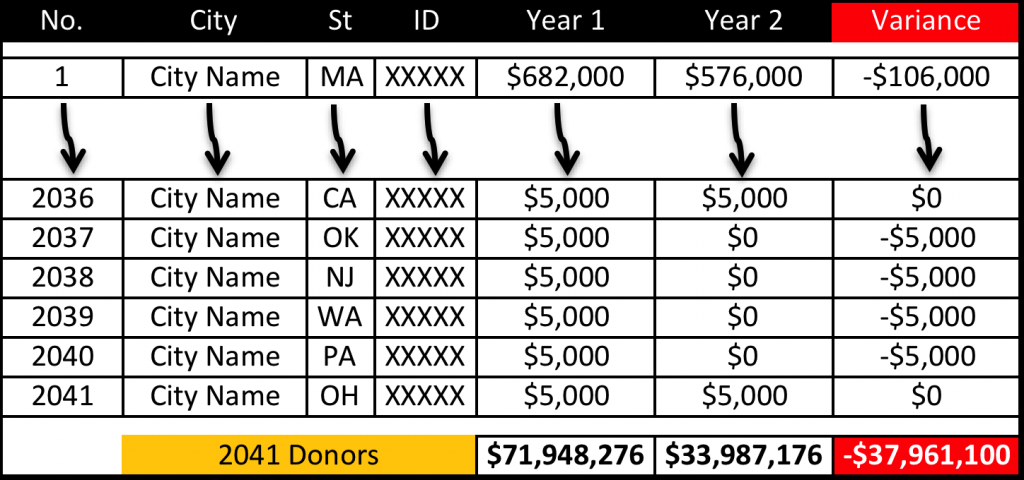
What’s wrong with this picture? Could it be that the top donor of this large non-profit gave $106,000 less from year 1 to year 2? Maybe.
Or that a group of $5,000 givers are just “missing in action” in year two? Yep.
All of that could be troubling. But most troubling is that the 2041 donors who gave $71.9 million to this non-profit in year 1 only gave $33.9 million in year 2, with the non-profit losing almost $40 million dollars!! I assure you, this is not because one or two big gifts have gone away and are skewing these numbers. There are hundreds and hundreds of donors who have just disappeared from one year to the next!
You would immediately know this well-known charity if I told you the name. They are a well-respected, well run organization that does some wonderful work. Did I say well-run? Yes – for the most part, they are. But sitting in the development department is a leader who probably needs to go, because his philosophy of donor management is hurting donors and the organization. (I’ve disguised the details of this case so there is no possibility this good person will be either shamed or harmed). I say “good person” because he IS a good person. He is simply misguided in his approach to major gift fundraising.
What’s wrong with this leader’s approach can be summed up in 4 points:
- He values the new prospective donor more than he does a current, ongoing donor. He has built an impressive prospecting machine inside the organization, which trolls for high net worth people who can be approached for a donation. When I suggest that it would be good to direct those prospecting and research skills toward learning more about his current donors, he puts me off, saying that his main objective is to find new donors for the organization.
- He cares more about growth than retaining existing donors. He is obsessed with growth, and if it is double digits from year to year, he is truly happy. Never mind that he is buying growth mostly through donor prospecting and acquisition, and his current donor retention and upgrading metrics are trending down. All of this is hurting his fundraising ratios, which are getting worse. Don’t get me wrong – Jeff and I are pro-growth. But it needs to be through a balanced approach of acquisition, prospecting and current donor cultivation and retention.
- He is covering up the loss of old money by layering new money on top. This is a common situation Jeff and I find in many non-profits in North America and Europe. Here is what it looks like: the bottom line revenue number is going up from year to year – but when you look at groups of donors the way we do and how they have performed from year to year, you find major losses of “old” money covered up by incoming “new” money. Take the situation illustrated in the chart above. That loss of $40 million dollars is “covered up” by new money that has come in. Top management is not even aware of this dynamic. Tragic.
- He shuns analysis that will reveal what is truly happening in his donor file. I find this one point to be the most interesting to me. If your body was racked with pain and you obviously had some serious medical problems going on and the doctor prescribed some diagnosis, like a blood test or X-ray or CAT scan etc. – if your doctor prescribed this, would you just brush her aside and say: “Nope. Don’t need it. Not going to do it!” Of course not! Why? Because you are under threat of a serious health problem or possible death. But Jeff and I find scores of leaders who will not do the analysis, even though we offer it for free, because – well, I really don’t know why. I don’t. It’s crazy. Goodness, facts are truly friendly! Why not expose yourself to the facts?
Bottom-line, this leader has contempt for the current donors on his file. I know that is a rather strong thing to say. But seriously, this kind of behavior is just wrong. And the numbers are basically telling the story of hundreds of donors who are collectively saying: “You don’t value me; you are not telling me my giving is making any difference. So I am going away, to another organization, to make a difference.”
Here’s what you can do to make sure you are not in this situation:
- Do the analysis so you know what is going on. It is simple to do, and if you can’t do it internally let us help you. We’ll do it for FREE! But do it! You need to know the facts about your donor file.
- Audit the attitudes about donors in your organization. Get a fix on how the good people in your non-profit think and feel about donors. The best way to get to this quickly is to examine the thank-you process and system you have in place. If it takes weeks to get a thank-you out to a donor, that is a huge clue. If it is difficult to find information to send to donors about how their giving is making a difference, that is another huge clue. If management is unwilling to spend money on donor care – another clue. If donors are treated as sources of cash, rather than as partners in doing good, you have identified one more clue. All the facts are sitting right in front of you. Uncover them.
- Set your mind to do something about it. If your organization is not as donor-centered as it could be, decide to become an internal donor advocate. Believe me, if you do the analysis in #1 above and it shows huge losses from year to year, you will be armed with the best argument why management should shift budget and efforts to caring for donors. Loss of money usually talks!
- Examine your own heart and attitude. It is true that the familiar does get boring and, well, familiar. I, for one, have to work at staying interested. So if, in your inner self, it is “hard to deal with those donors” grab yourself by the lapels and do some serious attitude adjustment work. It will honor the donor, help the organization and be good for you.
Our donors are such a wonderful gift to us. And they, collectively, are doing so much good work in our world. Let’s agree to examine ourselves to make sure we are doing everything we can to honor them and lift them up.
Richard
P.S. We’d really love to do an audit on your donor file so you have the facts. We do this at no cost if you allow us to tell you where there is opportunity for growth and how Veritus Group can help you. Just click here!




I couldn’t agree more. And the best part is, well cared for donors not only give more during their lifetimes, they do three more things that help our organizations:
1) they refer their friends, family and colleagues to us;
2) they mention us to their professional advisers who then refer more clients to us; and
3) they include us in their estate plan to receive much larger gifts than they could do during lifetime.
It’s a “no-brainer – IMHO